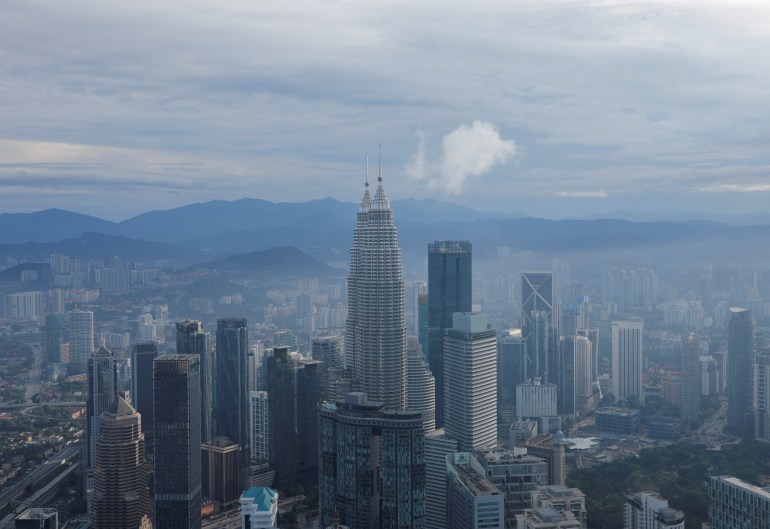Malaysia sees Chinese tourist boom in the offing after pandemic slump
Kuala Lumpur, Malaysia – Chinese tourists are returning to Malaysia en masse after the COVID-19 pandemic slump, industry figures say, amid expectations arrivals could reach pre-pandemic levels this year following the introduction of visa-free entry.
Mint Leong, president of the Malaysian Inbound Tourism Association, estimated that arrivals rose to 60,000 in January, up from about 45,000 last year, and as high as 120,000 in February during the Lunar New Year period.
“Chinese New Year will be the best arrivals post-COVID-19,” Leong told Al Jazeera.
Leong said he expects Chinese arrivals to reach 3.5-4.5 million this year, with the average tourist spending 5,000-6,000 Malaysian ringgits ($1,000-$1,200) during their trip.
Before the pandemic, China was the third-largest source of tourists after Singapore and Indonesia, sending 3.1 million visitors in 2019.
The Malaysian government has set a target of 5 million Chinese visitors in 2024, hoping to deliver a jolt to the post-pandemic recovery of Southeast Asia’s fifth-largest economy.
Malaysia’s economy grew 3.7 percent in 2023, missing official targets and lagging behind regional neighbours such as Indonesia and the Philippines.
In December, Kuala Lumpur introduced visa-free entry for Chinese citizens, allowing visitors to stay in the country for up to 30 days for travel and leisure purposes.
The move added Malaysia to the list of 88 countries and territories that Chinese travellers, whose passport ranks 62nd on the Henley Passport Index for ease of travel, can visit without needing to apply for a visa.
“The visa-free deal will definitely boost Chinese tourist arrivals in Malaysia to aid stronger tourism and related services growth,” Lee Heng Guei, an economist and executive director of the Kuala Lumpur-based Socio Economic Research Center (SERC), told Al Jazeera.
“I expect the number to recover back to pre-pandemic levels this year,” Lee said.

In Kuala Lumpur, hoteliers have reported a noticeable uptick in Chinese bookings during the Lunar New Year period and expressed optimism that their numbers will remain strong throughout the year.
Gregory Gubiani, general manager at the five-star Westin Kuala Lumpur, which is popular with Chinese tourists due to its location in the busy Bukit Bintang shopping district, said Chinese arrivals doubled in January 2024 compared with last year.
“There was a high influx of mainland Chinese here at The Westin Kuala Lumpur and its vicinity recently during the Lunar New Year period,” Gubiani told Al Jazeera, explaining that guests typically stayed 2-3 nights at about 600 ringgit ($127) per room per night.
Gubiani said that although bookings had yet to recover to pre-pandemic levels, the visa-free entry policy would contribute to the “upward trend.”
EQ, another 5-star hotel in the city centre popular with Chinese travellers, also experienced a surge in Chinese arrivals during the Lunar New Year period.
“These numbers are forecasted to remain steady and grow throughout the year. Increased flights from regional centres and larger capacity aeroplanes also play a part in the increasing number of arrivals,” EQ’s general manager Gerard Walker told Al Jazeera.
“The increased number of flights per day in the January to March period also point to Malaysia being an attractive travel prospect, or alternative destination to other, more crowded Southeast Asian destinations.”
Walker said his hotel’s “dynamic mix of guests” includes Chinese coming to Malaysia for luxury shopping and golf, and business guests coming for high-level business meetings.
“The stays are usually part of onward travel to other destinations in Southeast Asia, as part of a longer holiday,” he said.
“Our exchange rate, the cost of dining, the high-value experiences and outstanding appeal of hotels like EQ, makes Malaysia a positive alternative to other overcrowded destinations such as Bangkok.”

Yeah Kim Leng, an economics professor at Sunway University, said that China’s huge middle-class population should be able to sustain the influx into Malaysia despite slowing growth in the world’s second-largest economy amid weak consumption, a shrinking population and a property market slump.
“Although a significant number of the middle class have been negatively affected by the slowing economy and property market distress, the sizeable middle-class population coupled with high savings rate will likely sustain China’s outbound tourism that has been eagerly awaited by Malaysia and other countries in the region,” Yeah told Al Jazeera.
Yeah said the scale of outbound travel from China would depend on Beijing’s willingness to provide fiscal support and undertake reforms to encourage a shift away from investment-driven growth towards a consumption-led model.
Malaya’s tourism sector was worth an estimated 251.5 billion ringgit ($53bn), or 14 percent of the gross domestic product in 2022, according to the Department of Statistics Malaysia.
Total tourism spending amounted to 92.7 billion ringgit ($19.6bn), of which 33.4 billion ringgit ($7bn), or 36.1 percent, came from foreign tourists.
While China accounted for the third-largest number of tourists, Chinese visitors’ average spending was among the highest for foreign visitors.
Chinese tourists spent an average of 661-768 ringgit ($140-$162) per day in Malaysia between 2017 and 2019, 19 to 72 percent higher than the average tourist, according to research by Hong Leong Investment Bank Research
“Hence, the expected boost in their numbers due to the visa-free initiative could have a significant impact on tourism spending in the country,” Yeah said.




